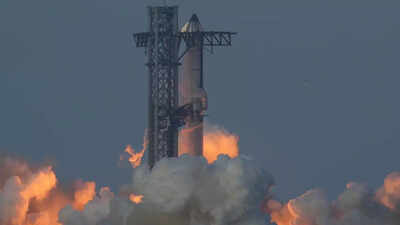ARTICLE AD BOX

After two consecutive
launch delays
, SpaceX achieved a major milestone on Tuesday with the successful tenth test flight of its
Starship rocket
. The 403-foot-tall (123-meter) stainless steel spacecraft lifted off from Starbase, Texas at 6:30 p.m. local time, marking a significant step forward in the company’s reusable rocket program. The mission tested multiple upgrades, including new
heat shield
tiles and a
satellite deployment system
, while demonstrating the vehicle’s ability to withstand intense reentry heat. The Super Heavy booster and Starship upper stage both completed planned maneuvers, signaling progress despite a history of explosive failures in previous tests.
Elon Musk’s SpaceX overcomes past failures
This milestone comes after several high-profile failures, including three consecutive upper stage explosions in past flights and a catastrophic ground test in June. Previous scrubs also delayed the launch, with Sunday’s attempt halted due to a liquid oxygen leak and Monday’s blocked by cloudy weather. SpaceX’s “fail fast, learn fast” philosophy has enabled engineers to gather crucial real-world data, helping refine Starship’s reusable design and improving confidence in its reliability for future missions.
Key objectives of the tenth flight
Tuesday’s mission tested critical systems, including:
- The heat shield tiles on the Starship upper stage, designed to endure extreme atmospheric reentry temperatures.
- The Pez-like satellite deployment system, which successfully released mock Starlink satellites.
- Engine performance under off-nominal scenarios, with one of the booster’s landing engines deliberately shut down to simulate failure.
- The upper stage completed a suborbital trajectory and splashed down safely in the Indian Ocean, while the Super Heavy booster splashed down in the Gulf of Mexico.
Engineering achievements and remaining challenges
Although the protective skirt around the upper stage engines and one control flap showed signs of melting, the vehicle remained fully controllable throughout descent. Elon Musk emphasized that developing a fully reusable orbital heat shield is one of Starship’s toughest challenges, noting that it took nine months to refurbish the Space Shuttle heat shield between flights. In addition, in-orbit refueling with super-cooled propellants remains untested but is essential for deep-space missions, including lunar landings and Mars missions.
Implications for NASA and SpaceX missions
Starship’s success is critical for NASA’s Artemis program, which relies on a modified Starship to land astronauts on the moon by 2027. The mission also supports SpaceX’s Starlink satellite deployment, allowing larger batches of satellites to reach orbit. Despite technical hurdles, the tenth flight demonstrated measurable progress toward operational missions, reaffirming Musk’s vision of high-frequency launches and eventual Mars colonization.
The path ahead for SpaceX
While Tuesday’s flight marks a major achievement, observers caution that significant engineering and logistical challenges remain. From safe lunar landings to orbital propellant transfers and operational reliability, Starship’s journey is far from complete. Yet, SpaceX’s iterative approach continues to push the boundaries of
reusable rocket technology
, offering a glimpse of what could become routine
interplanetary travel
in the coming decade.



.png)
.png)
.png)
















 3 hours ago
3
3 hours ago
3








 English (US) ·
English (US) ·